Introduction: Why Ecommerce Marketplace Management Matters More Than Ever in 2025
In the hypercompetitive digital landscape of 2025, ecommerce marketplace management has evolved from a nice-to-have capability into a core business function. For manufacturers, distributors, wholesalers, and B2B sellers, embracing ecommerce for manufacturers is no longer optional. It's essential.
The rise of multichannel and omnichannel commerce, the need for operational efficiency, and the expectations of digitally savvy B2B buyers are driving the need for robust ecommerce marketplace management strategies. Whether you sell on Amazon, Alibaba, your own B2B ecommerce platform, or a combination of wholesale ecommerce platforms, managing these channels effectively is key to sustainable growth.
This comprehensive guide dives into the essentials of ecommerce marketplace management, with a focus on B2B ecommerce solutions tailored for manufacturers. It also explores how B2Sell's powerful integrations can help streamline your operations, increase visibility, and boost conversions.
What is Ecommerce Marketplace Management?
Definition
Ecommerce marketplace management refers to the process of overseeing, optimizing, and automating operations across multiple online selling channels. It includes managing listings, pricing, inventory, fulfillment, customer service, and analytics across platforms like Amazon, Walmart Marketplace, eBay, and dedicated B2B ecommerce platforms.
Why It Matters for Manufacturers
- Centralizes operations
- Enables multichannel ecommerce
- Enhances buyer experience
- Reduces manual workload
- Scales sales reach across regions
Benefits of Marketplace Management for B2B Sellers and Manufacturers
1. Centralized Product Data Management
With a Product Information Management (PIM) solution integrated with your ecommerce channels, manufacturers can maintain consistent product data across all platforms.
2. Improved Operational Efficiency
Marketplace automation eliminates manual processes, reducing errors in pricing, inventory syncing, and order routing.
3. Greater Market Reach
Manage listings on multiple wholesale ecommerce platforms and marketplaces simultaneously to access new customer segments.
4. Real-time Analytics and Performance Tracking
Gain actionable insights across all channels, helping you optimize pricing, inventory, and marketing strategies.
5. Enhanced Customer Experience
By offering accurate inventory data, quick shipping options, and unified branding across touchpoints, brands deliver a seamless buyer journey.
6. Faster Time to Market
Centralized content and automation tools help brands onboard new products across all channels within days instead of weeks.
7. Reduced Operational Costs
By consolidating platforms and reducing manual labor, companies significantly lower their cost-per-order and cost-per-acquisition.
Top Challenges in Ecommerce Marketplace Management (And How to Solve Them)

1. Fragmented Product and Inventory Data
Without integration, it's easy to lose track of inventory or publish outdated product info. Solution: Use a multichannel ecommerce platform with centralized data management.
2. Listing Errors and Marketplace Restrictions
Listings that don’t meet a marketplace’s content guidelines can be penalized or removed. Solution: Automate compliance checks and utilize template-based listing tools.
3. Order Fulfillment Complexities
Multiple fulfillment options can lead to errors, delays, or duplicate shipments. Solution: Automate order routing with logic-based workflows and sync logistics partners.
4. Channel Cannibalization
Improper pricing or overlapping SKUs can create channel conflict or undercutting. Solution: Segment inventory, customize pricing strategies per channel, and control availability.
5. Poor Reporting and KPIs
Without detailed reporting, performance bottlenecks go unnoticed. Solution: Implement dashboards that offer channel-specific and aggregated analytics.
6. Delayed Customer Communication
Without proper alerts and automation, response delays lead to poor reviews. Solution: Use integrated CRM tools to automate emails, tracking updates, and customer notifications.
7. Scaling Globally
Expanding into global marketplaces involves localization, translations, and compliance. Solution: Choose a platform with localization features and global tax/VAT support.
Key Features to Look for in a B2B Ecommerce Marketplace Management Platform
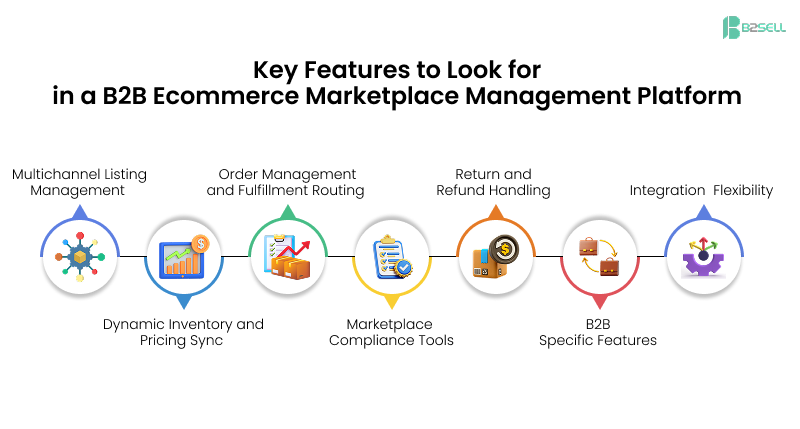
1. Multichannel Listing Management
Create, update, and optimize product listings across multiple channels from one dashboard.
2. Dynamic Inventory and Pricing Sync
Ensure real-time sync of stock levels and pricing data across all platforms to avoid overselling.
3. Order Management and Fulfillment Routing
Automatically direct orders to the best warehouse, supplier, or drop-shipper.
4. Marketplace Compliance Tools
Ensure listing formats, character limits, imagery, and data fields meet each marketplace’s requirements.
5. Return and Refund Handling
Centralized systems help track returns and issue refunds while keeping customer records intact.
6. B2B-Specific Features
Tiered pricing, volume discounts, custom catalogs, net payment terms, and quote requests.
7. Integration Flexibility
Pre-built connectors for ERP, CRM, shipping, and tax platforms reduce deployment time and costs.
How Ecommerce for Manufacturers is Evolving
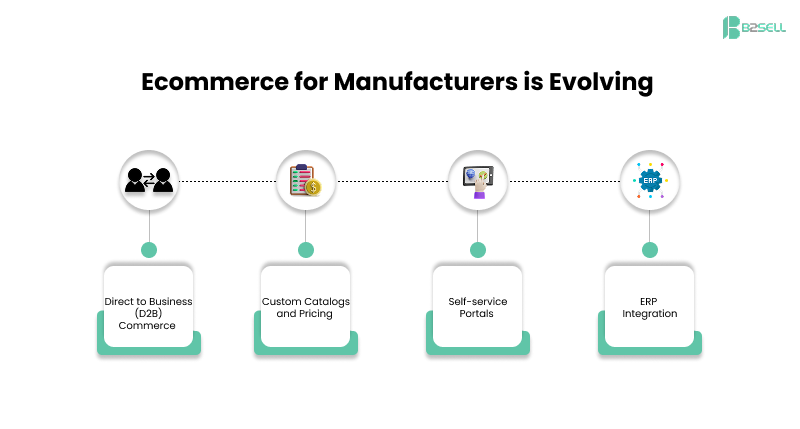
a. Direct-to-Business (D2B) Commerce
Manufacturers are increasingly cutting out middlemen by selling directly to retailers, resellers, and end customers.
b. Custom Catalogs and Pricing
Modern B2B ecommerce platforms support account-specific catalogs, tiered pricing, and quote-based workflows.
c. Self-service Portals
Buyers can log in, reorder, request quotes, download invoices, and track deliveries on their own.
d. ERP Integration
Tight integration with SAP, NetSuite, QuickBooks, or Infor helps sync product, customer, and financial data.
B2B Ecommerce Examples in Action
1. Industrial Equipment Manufacturer
Uses a multichannel ecommerce platform to sell on Amazon Business and a private B2B portal, syncing inventory and orders in real-time.
2. Medical Supply Distributor
Uses a PIM-integrated wholesale ecommerce platform to update thousands of SKUs across regional marketplaces.
3. Automotive Parts Supplier
Combines ERP and ecommerce systems using B2Sell integrations to automate invoicing, fulfillment, and customer service.
Step-by-Step Guide to Effective Ecommerce Marketplace Management
Step 1: Audit Your Current Ecosystem
Identify all your sales channels, tools, and manual processes.
Step 2: Choose the Right B2B Ecommerce Platform
Select a platform that supports multichannel commerce, automation, and scalability.
Step 3: Implement a Centralized PIM Solution
Ensure consistent, enriched product content across all your marketplaces.
Step 4: Set Up Channel-specific Rules
Create custom workflows for pricing, order routing, and customer notifications.
Step 5: Leverage Automation & Integrations
Use platforms like B2Sell to connect ERP, shipping, and ecommerce for seamless operations.
Step 6: Monitor KPIs & Optimize
Track sales, returns, fulfillment rates, and customer satisfaction for each channel.
How B2Sell Powers Seamless Marketplace Management
B2Sell offers pre-built and customizable integrations with top B2B ecommerce platforms, PIMs, ERPs, CRMs, and shipping systems.
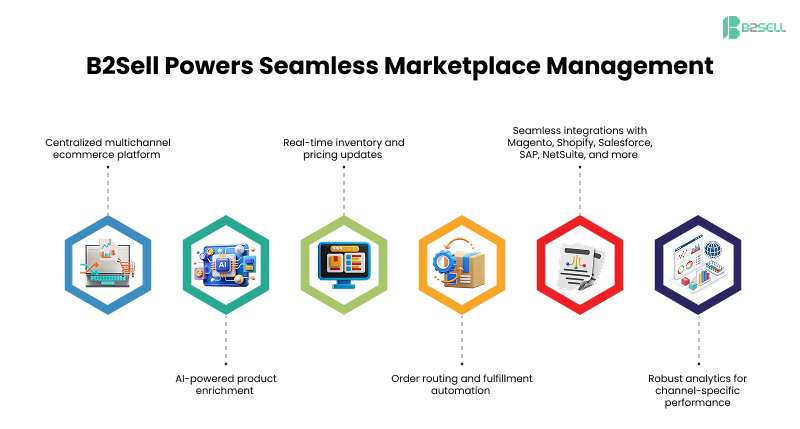
Key Capabilities:
- Centralized multichannel ecommerce platform
- AI-powered product enrichment
- Real-time inventory and pricing updates
- Order routing and fulfillment automation
- Seamless integrations with Magento, Shopify, Salesforce, SAP, NetSuite, and more
- Robust analytics for channel-specific performance
B2Sell empowers manufacturers and B2B sellers to scale without the complexity of fragmented systems.
FAQs on Ecommerce Marketplace Management
What is ecommerce marketplace management?
It refers to the process of managing products, orders, inventory, and customer service across multiple online sales channels.
What’s the best ecommerce platform for manufacturers?
Platforms that support B2B workflows, ERP integrations, and multichannel commerce—like B2Sell + Magento or Shopify B2B.
Can B2B companies benefit from selling on marketplaces?
Absolutely. Marketplaces like Amazon Business or Alibaba open new sales channels, increase visibility, and improve cash flow.
What is the difference between multichannel and omnichannel commerce?
Multichannel means selling on multiple channels independently. Omnichannel unifies those channels for a seamless customer experience.
What are examples of B2B ecommerce?
Examples include manufacturers selling industrial parts to distributors, or wholesalers offering office supplies to large enterprises.
Final Thoughts: Elevate Your Marketplace Strategy with B2Sell
Ecommerce marketplace management isn’t just about surviving in the digital economy—it’s about thriving. Manufacturers and B2B sellers must invest in scalable, integrated, and automated platforms that reduce friction and drive growth.
B2Sell is your trusted partner in simplifying ecommerce for manufacturers. With robust integrations, multichannel capabilities, and future-ready tools, we help you transform challenges into opportunities.
👉 Explore B2Sell Integrations and unlock the full potential of your ecommerce marketplace strategy.

.png)
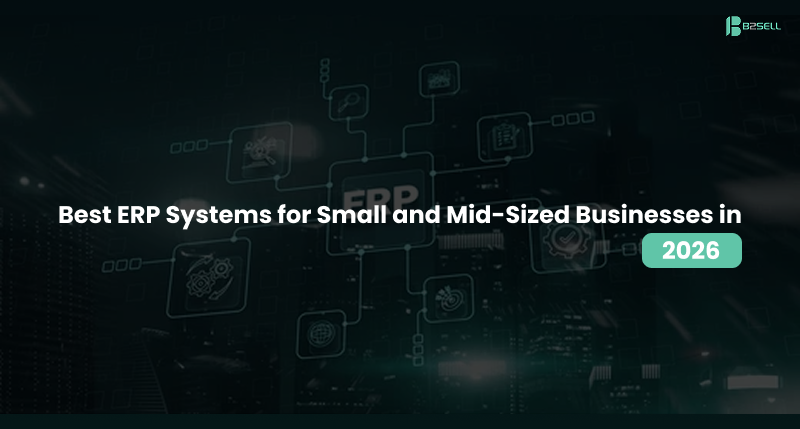

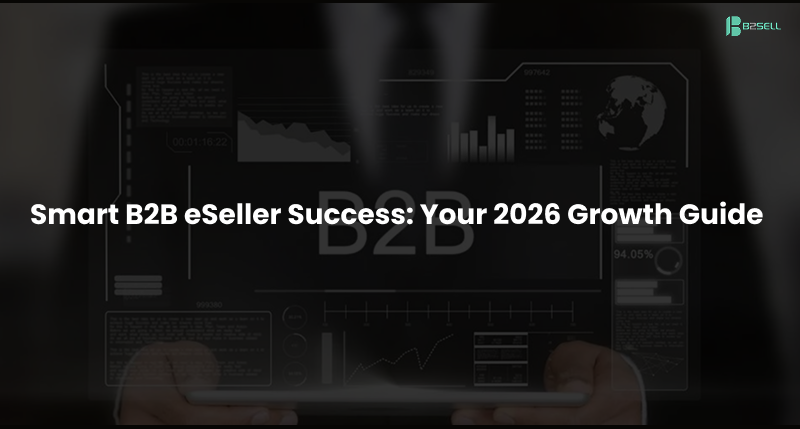


.png)